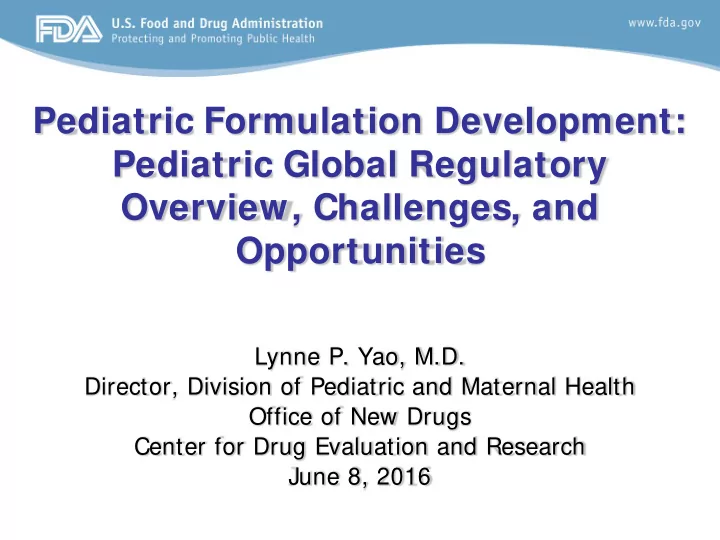

Pediatric Formulation Development: Pediatric Global Regulatory Overview, Challenges, and Opportunities Lynne P. Yao, M.D. Director, Division of Pediatric and Maternal Health Office of New Drugs Center for Drug Evaluation and Research June 8, 2016
Disclosure Statement • I have no financial relationships to disclose relating to this presentation • The views expressed in this talk represent my opinions and do not necessarily represent the views of FDA 2
Pediatric Drug Development General Principles • Pediatric patients should have access to products that have been appropriately evaluated • Product development programs should include pediatric studies when pediatric use is anticipated From FDA guidance to industry titled E11 - Clinical Investigation of Medicinal Products in the Pediatric Population, December 2000 3
• Sulfanilamide is an antibiotic (drug used to treat infections) and saved many lives • Only available in pill or powder • Mixed with an untested chemical, diethylene glycol, to make it easier to give to children • Elixir of Sulfanilamide introduced in September 1937 • Turns out diethylene glycol is highly toxic • Cause 107 deaths in 15 states
Sulfanilamide Tragedy • Congress passed the Food, Drug and Cosmetic Act on June 25, 1938 • Signed into law by Franklin D. Roosevelt • A manufacturer of a drug must prove to FDA that their drug is safe before it can be sold
Kearns, et al., Developmental Pharmacology —Drug Disposition, Action, and Therapy in Infants and Children, N Engl J Med 2003;349:1157-67.
U.S. Pediatric Drug Development Laws • Best Pharmaceuticals for Children Act (BPCA) – Provides a financial incentive to companies to voluntarily conduct pediatric studies – FDA and the National Institutes of Health partner to obtain information to support labeling of products used in pediatric patients (Section 409I of the Public Health Service Act) • Pediatric Research Equity Act (PREA) – Requires companies to assess safety and effectiveness of certain products in pediatric patients • Studies are completed using appropriate formulations 7
EU Paediatric Regulation • Includes similar provisions for incentives and requirements to conduct pediatric studies • Article 15 requires any measures to adapt the formulation of the medicinal product to be age-appropriate in different subsets of the paediatric popluations in the paediatric investigation plan (PIP)
General Approach to Pediatric Product Development • Evaluate all possible indications based on the mechanism of action of product – Literature review, data from other development programs, proof of concept studies, etc. • Consultation with pediatric experts to assess each indication • Determine what data would be needed to initiate studies in pediatrics – Is there a potential for developmental toxicities that may require juvenile animal studies? – Are there additional adult human data? – Will a different formulation for use in pediatrics be needed?
General Considerations in Pediatric Formulation Development • Route of administration – Oral and Intravenous – Oromucosal, nasal, Inhaled, rectal, transdermal • Efficacy and Safety – Dosage forms are bioavailable – Dose allows for accuracy for all pediatric age groups – Dose can be easily or readily administered – Amount and number of excipients safe for all pediatric age groups – Dosage forms are stable • Acceptability – Palatability – Swallowability • Affordability
Newer Approaches to Oral Formulations • Multiparticulate drug delivery systems – Granules, pellets, minitablets – Reduced size intended to improve ease of swallowing and increased dose flexibility – Stability and transportation advantages • Orodispersible tablets and films – Swallowing of dose not required • Chewable formulations – Swallowing aided by ability to chew • Use of these formulations still problematic for youngest patients
Recent Pediatric Approvals for Novel Dosage Form • Adenzys XR-ODT (Amphetamine extended-release orally disintegrating tablets) – Indicated for treatment of ADHD – Approved 1/27/2016 – Demonstrated comparable plasma concentration profiles to amphetamine extended-release capsules – May be taken with or without food. Allow tablet to disintegrate in saliva then swallow • Narcan nasal spray – Indicated for emergency treatment of known or suspected opioid overdose – Approved November 18, 2015 – Instructions for use similar for adults and pediatric patients – Consider alternate naloxone-containing products in neonates with known or suspected exposure to maternal opioid use to avoid precipitation of opioid withdrawal symptoms
Ongoing Global Efforts • NIH/FDA • Inter-Agency Agreement for Pediatric Formulations Platform in 2009 – Assessment of pediatric product formulations – Open-source, publicly available approach to pediatric oral formulations manufacturing • https://bpca.nichd.nih.gov/collaborativeeff orts/initiatives/Documents/Formulations_Pl atform_Report2.pdf
Ongoing Global Efforts • World Health Organization "Make medicines child size" – Development of paediatric medicines: points to consider in pharmaceutical formulation, 2012 – Inform regulatory authorities and manufacturers on issues that require special attention in pharmaceutical formulation. Its focus is on the conditions and needs in developing countries. http://apps.who.int/medicinedocs/documents/s19833en/s198 33en.pdf • International Conference on Harmonization (ICH) – Addendum to E11 guideline: Clinical Investigation of Medicinal Products in the Pediatric Population – Includes update on considerations related to development of pediatric formulations
Challenges and Opportunities • Neonates – Special considerations include limitations on volume, compatibility, excipients • Novel technologies for improving solubility and permeability with safe excipients – Requires efforts from chemists, clinical pharmacologists, toxicologists, engineers, and patients/caregivers
Challenges and Opportunities • Long-term safety – Additional data on long-term safety not limited to the active ingredients but also on excipients • Evidence-based acceptability and adherence – Patient and prescriber feedback on performance of novel formulations • Sharing of information/Collaboration – Clinical trial networks and pre-market collaboration may also improve speed/efficiency of development of age-appropriate formulations
Thank you
Recommend
More recommend